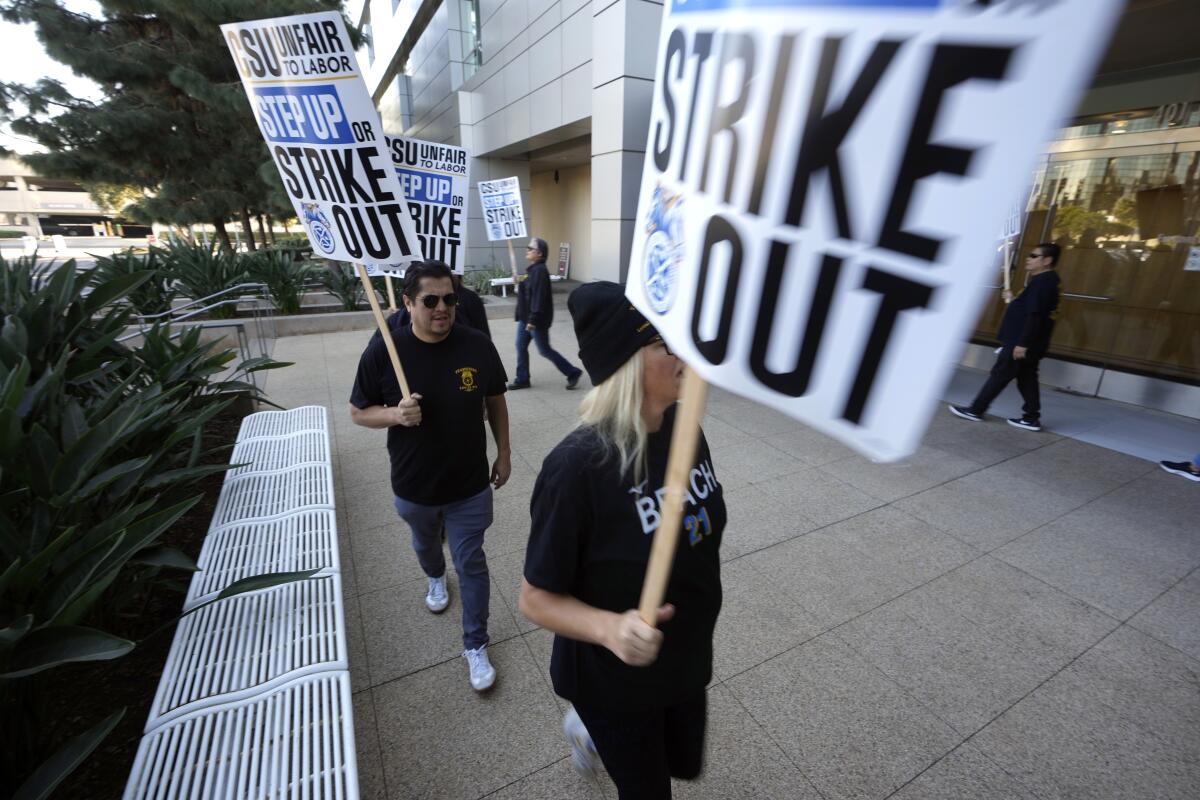Opinion: I’m a CSU professor. I have serious doubts about the demands behind a threatened strike

- Share via
The union that represents California State University faculty is set to launch a strike across the system’s 23 campuses, citing the university’s unwillingness to raise salaries 12%, expand parental leave, reduce workloads and more. Unfortunately, however, the union’s demands could unintentionally hurt the people they are intended to help.
My experience as a former chair of San Jose State’s Justice Studies Department taught me that no proposal comes without a cost. The question is who will shoulder the greatest burden, students or faculty?
Let’s start with the proposed salary increase covering approximately 29,000 employees. The union argues that a 12% raise is necessary to keep pace with inflation and community college salaries.
Homeless college students who live in their cars need safe overnight parking. How tough can that be?
Colleges such as Cal Poly Humboldt resist allowing overnight parking for students who live out of their cars. Long Beach City College shows a better way.
But according to CSU, such a salary hike would result in $380 million in recurring costs, much more than the $227 million in annual funding dedicated to the system in the last state budget. System officials warned that the proposal is “not financially sustainable … and would result in painful cuts on our campuses, including layoffs.” San Francisco State, which was forced to cut the equivalent of 125 full-time positions and numerous classes because of budget shortfalls, is an example of the potential consequences.
An independent fact-finding report similarly concludes that a 12% salary increase would be unsustainable for the system. It recommended a 7% increase.
The union’s proposal also overlooks established economic theory and research on raising wages, which show that increased labor costs are often passed on to consumers — in this case, students — and employees in the form of reduced hours and other measures.
Where Americans see a student debt crisis, culture wars and other challenges plaguing our higher education, people in other countries see opportunity.
Cutting costs often disproportionately affects vulnerable employees such as part-time faculty. These faculty members have the least job security and are most susceptible to budgetary pressures. As the cost of labor rises, administrators frequently resort to cost-cutting measures such as raising workloads and targeting low-enrollment courses, leading to course cancellations, loss of medical benefits and layoffs among part-time faculty. A union official in San Francisco lamented that “over 300 lecturer faculty are about to lose their jobs and health care because of the cuts.”
Another group likely to be affected by increased university costs is students. Faculty salaries and benefits are the university’s greatest expense, with every percentage point increase costing the system about $55 million. If the union’s proposals prevail, tuition is likely to go up, and students will suffer for it. Too many CSU students are already hard-pressed to afford tuition and housing.
Full-time faculty members won’t escape the impact either. While they may initially benefit from increased compensation, administrators may cut expenses such as training and releases from teaching obligations to conduct research. The result would be more crowded courses, less research time and fewer opportunities for professional development.
The union’s proposals should also be evaluated in the context of declining college enrollment nationwide and in California. Several CSU campuses have missed enrollment targets by 10% or more, CalMatters reported, and the system lost more than 27,000 students in two years, equivalent to a $162-million shortfall.
I hope the system’s administrators and the union will consider a few other ways of balancing the budget while improving working conditions:
Recalibrate administrative staffing and pay: The number of university administrators has skyrocketed since the 1970s. The number and compensation of new administrative positions should be capped.
Allow greater workloads: The union’s rigid stance on this issue leads campuses to hire multiple faculty members to address one-time needs. Allowing faculty to teach one or two additional courses is a cost-effective alternative.
Award salary increases based on the cost of living: A uniform 12% salary increase irrespective of housing and other costs in different regions would be illogical. Does it make sense to give the same raise to professors in San Jose and, say, Bakersfield, where costs are dramatically lower?
Cuts are already happening at San Jose State. If the union succeeds, I fear more will come.
Since CSU has already agreed to a 5% salary increase, perhaps we should defer these costly demands until we address enrollment shortfalls, reestablish students’ confidence in the value and price of a degree, and increase public support for higher education.
Claudio Vera Sanchez is a professor and programs coordinator at San Jose State University.
More to Read
A cure for the common opinion
Get thought-provoking perspectives with our weekly newsletter.
You may occasionally receive promotional content from the Los Angeles Times.












